- Home
- >
- Preservation Archaeology Blog
- >
- Rooms of Our Own

As one of the newest Archaeology Southwest staff members, I still marvel at how peaceful, inviting, and singular our workplace is. I’ve been spending a lot of time in the Archaeology Southwest library lately, researching older excavations in the Upper Gila area. Before starting this project, I hadn’t realized the depth of the collections housed in this deceptively cozy room. I’ve been able to find copies of books and articles on the Upper Gila stretching back to the earliest research in the 1920s. Importantly, this includes not only books from the major academic publishers, but also lots of “gray literature,” technical reports published by government and Cultural Resource Management organizations that are printed in very limited numbers. It’s not hard to understand why a book called Archaeological Testing of Site AR-06-03-02-70, Gila National Forest, Catron County, New Mexico wouldn’t have an enormous printing run, but these reports constitute the primary source of detailed information on many sites that may now lie under buildings or roads, making the books essential parts of the archaeological record. These items don’t often make it into university libraries and can take days to locate and borrow or copy. As with protecting sites, preserving these records of past excavations and surveys is an important part of our Preservation Archaeology mission.
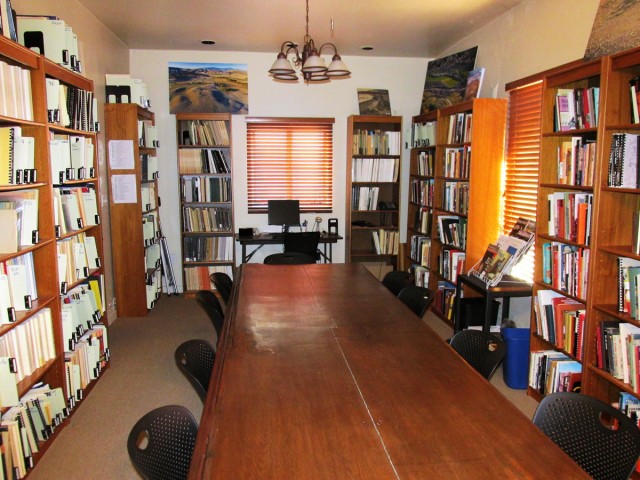
In addition to the information contained in these volumes, sometimes the books’ own histories make them exciting to use. It’s pretty cool to research a topic using the same book famed archaeologists such as Emil Haury or Julian Hayden once used! Our books’ interesting histories come thanks to a sometimes lengthy chain of ownership, as generations of archaeologists passed them on to younger researchers. Our library has benefited from the generous book donations of more than thirty people. Archaeologists such as William Robinson and Roger Anyon have donated large collections of books they no longer used often, and Steve Hayden donated items from his father Julian Hayden’s library. Estate gifts have also provided wonderful collections of hard-to-find volumes, including particularly generous gifts from the estates of Don Clifton, David Gregory, William Harrison, and Dwight Riggs. The bookshelves themselves once belonged to archaeologist Watson Smith. Katherine Cerino volunteers her time caring for the library collection to ensure that the books remain well organized and preserved.
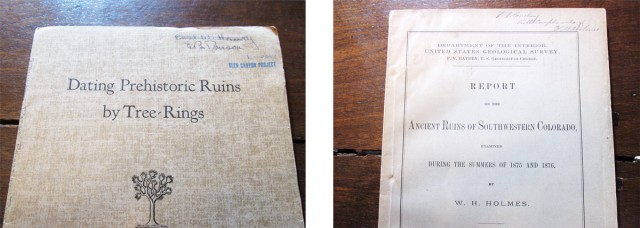
Using the on-site, noncirculating library is one of the benefits of Archaeology Southwest membership. Members can search our library catalog online, and are welcome to spend time reading at our big wooden library table or outside in the sunny courtyard. The courtyard plants include a baby fig tree descended from the same tree stocks grown by eighteenth-century southern Arizona missions, thanks to the Kino Heritage Fruit Trees Project and the Friends of Tucson’s Birthplace Mission Garden.
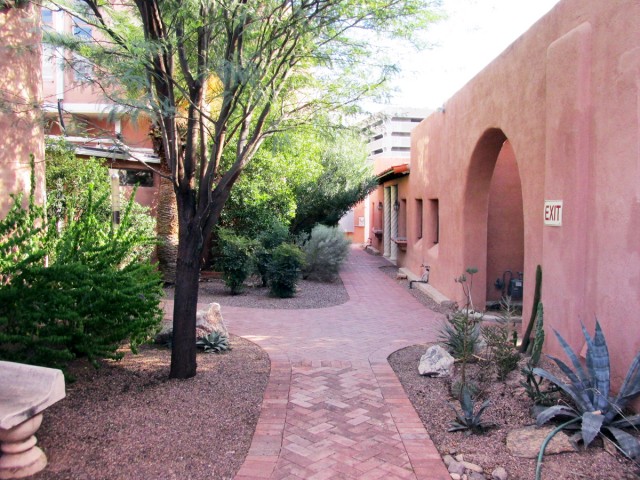
Another important space at Archaeology Southwest is our lab area, newly expanded to accommodate larger projects. Archaeology labs often end up in strange locations. I’ve worked in several basements and two slightly creepy old children’s hospitals, but this is the first lab I’ve seen in a former swimming pool! Our light and airy new lab space was once an upstairs pool in the Bates Mansion building (the third swimming pool here at the time—they must have really liked swimming). The south side of the room has computers and desk space for volunteers (such as the outstanding Peter Boyle and Georgiana Boyer, currently working on an Arizona State Museum accessioning project), whereas the far end of the filled-in pool now houses Preservation Archaeology Field School collections undergoing analysis. These collections were previously split among three smaller rooms, so having everything organized in one place will make research projects much easier. The central tables provide additional work space and a meeting area for groups too large to fit at our library table downstairs. The many windows look out towards the Santa Catalina Mountains on one side and downtown Tucson on the other, giving archaeologists and volunteers a pleasant visual respite from peering at pottery sherds.
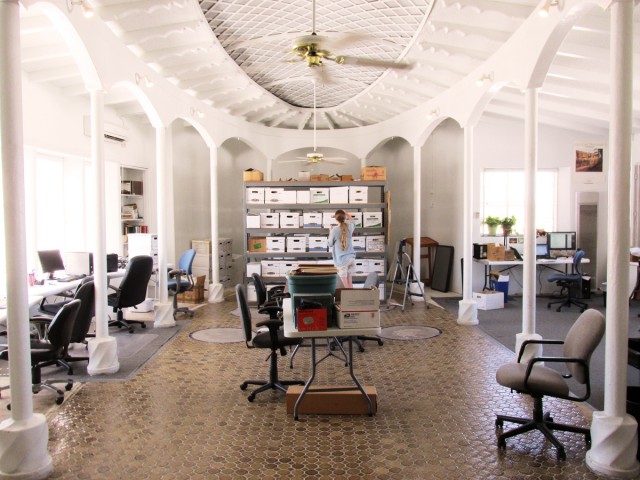
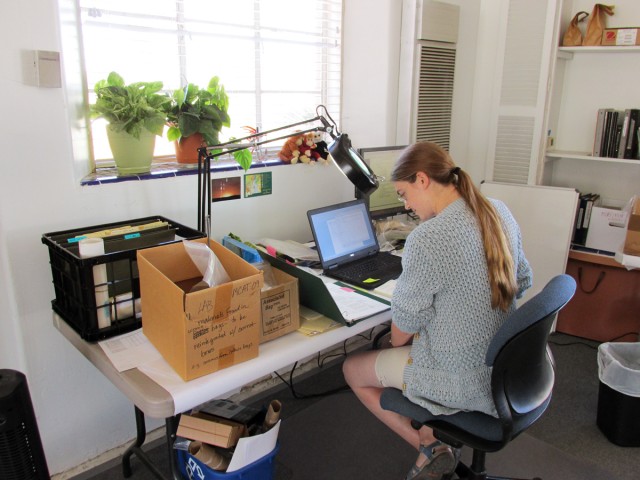
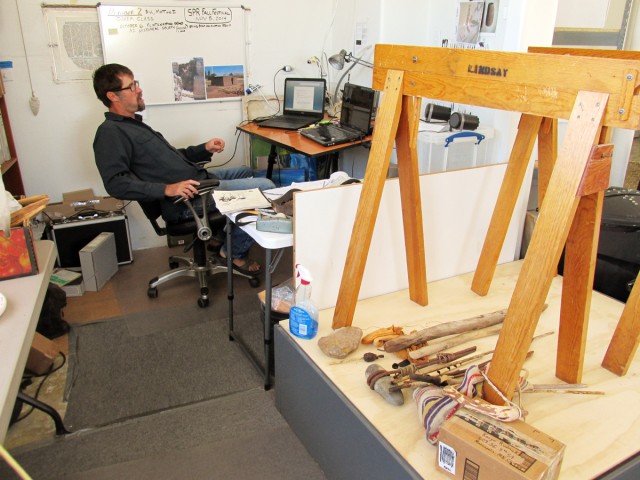
For a longer break, we can stretch our legs by walking downstairs to the Maker House (our tenants in the Bates Mansion building) for a cup of coffee and a look at the historic murals in the Corona Room (yet another former swimming pool, then a dining room, and now a classroom and gathering space). We’re looking forward to the possibilities this space gives us for group projects, and feel very lucky to be a part of this historic downtown building complex’s continuing story.
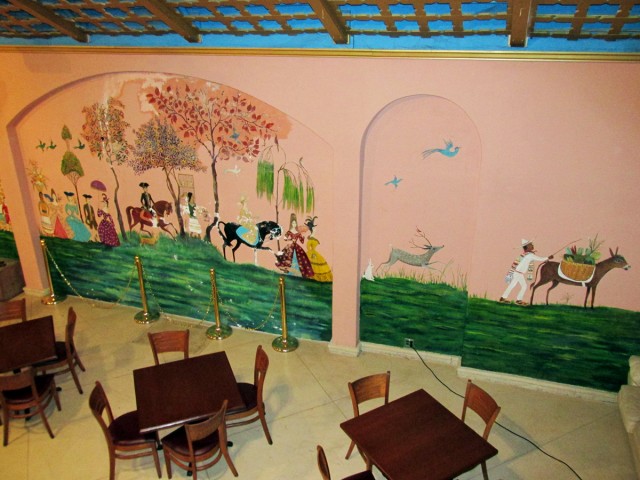
5 thoughts on “Rooms of Our Own”
Comments are closed.
Explore the News
-
Join Today
Keep up with the latest discoveries in southwestern archaeology. Join today, and receive Archaeology Southwest Magazine, among other member benefits.
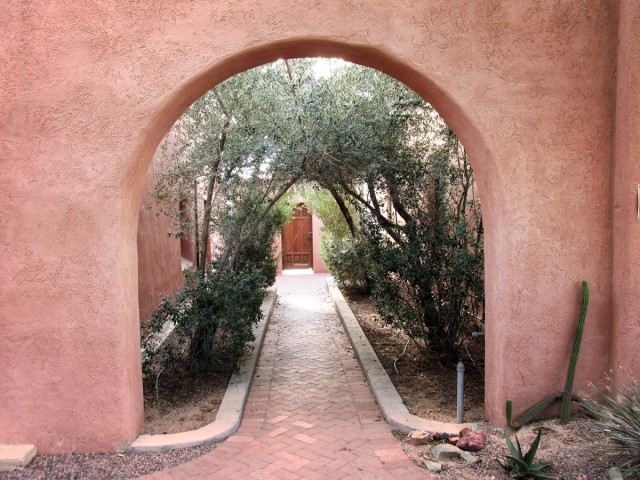
Thanks for the update on the new spaces. I heard there had been some changes made but had not gotten down to see them in person. I love how organized the library looks.
Karen,
Many thanks for “Rooms of Our Own” especially the library.
Katherine Cerino and I spent many hours organizing and receiving the Riggs and Gregory (as well as others)contributions after we moved from the University Blvd location. It is comforting to know that our efforts are useful to ongoing projects!
Bill
Thank you Bill, and thanks again to Elizabeth, Katherine, and everyone else who helped with the library– we are very lucky to have it! I used a copy of Sauer and Brand 1930 stamped “William Robinson” just yesterday.
Karen
Hi Karen, Thanks for your wonderful “report” on your working place. Linda showed us around this summer; it really is a cool place to work. Aside the books, Watson Smith’s book shelves are a piece of material culture with deep historic significance! Take care and cheers to all at ArchSW, Rob